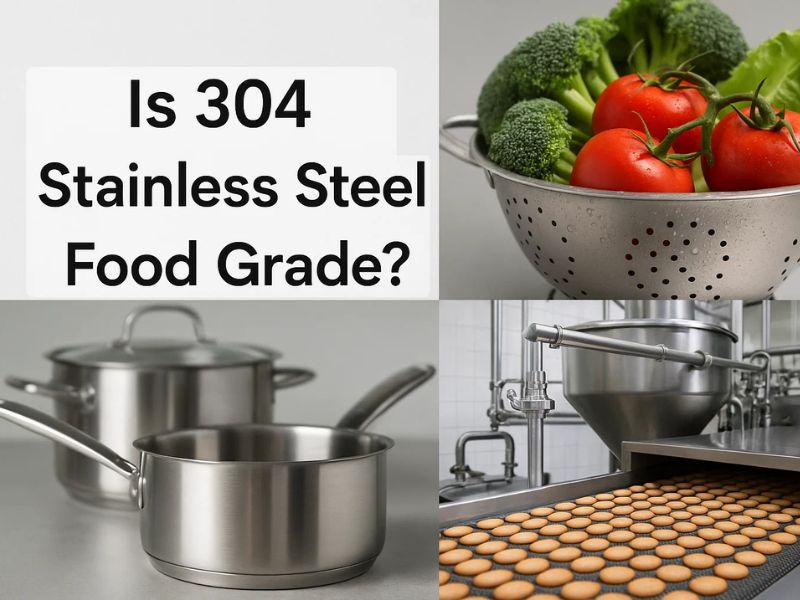- By Profab /
- October 14, 2025

You might ask if 304 stainless steel is food grade. Many countries have strong rules for materials that touch food. 304 stainless steel usually passes these rules. It does not rust and does not mix with food. Groups like the FDA, ANSI, and NSF say 304 stainless steel is safe for food. You can use it in your kitchen or food shop. Food-grade stainless steel needs the right metal mix and a smooth surface. This stops food from getting dirty and keeps your kitchen safe.
304 stainless steel is used a lot in food making and storing. Some people think all 304 stainless steel is food grade. That is not right. You should check if your product follows food safety rules in your country.
Table of Contents
What Makes 304 Stainless Steel Food Grade Safe
You may see numbers like 18/8 or 18/10 on kitchen items. These numbers show how much chromium and nickel are in the steel. Chromium makes the steel strong and stops rust. Nickel makes it shiny and helps fight acids. Both 18/8 and 18/10 are types of 304 stainless steel. You can use them for food because they are tough and safe.
Composition of 304 Food Grade Stainless Steel
You might wonder what makes 304 stainless steel so safe for food. The answer lies in its mix of metals. Chromium and nickel are the two main elements that give this steel its strength and shine. Chromium helps stop rust and keeps your kitchen tools looking new. Nickel adds extra resistance to acids and helps the steel last longer.
Here is a quick look at the typical content range:
Element | Content Range |
Chromium | 18.00–20.00% |
Nickel | 8.00–10.50% |
Most 304 stainless steel you find in kitchens has chromium between 17–20% and nickel between 8–11%. This balance helps answer the question: is 304 stainless steel food grade? Yes, this mix meets strict food safety standards.
Characteristics of 304 food grade stainless steel
Chemical Migration
You want to know if metals from your kitchen tools can get into your food. Scientists have studied this question. They tested 304 stainless steel with food acids and found that only tiny amounts of chromium and nickel move into food under normal use. These amounts stay well below safety limits set by health agencies.
Researchers used special tests, like total reflection X-ray fluorescence, to check for metal release. They found that washing and cleaning methods can change how much metal moves into food. Using gentle cleaners and rinsing well helps keep migration low. Food simulant studies also show that 304 stainless steel stays safe in most kitchen settings.
Heat Resistance
You often use stainless steel with hot foods or in ovens. 304 stainless steel stands up to high heat without breaking down or releasing harmful chemicals. You can use it for baking trays, oven racks, and cookware. It keeps its shape and does not warp easily. This makes it a top choice for both home and commercial kitchens.
Corrosion Resistance
You want kitchen tools that last a long time. 304 stainless steel does not rust or stain easily. This is because it has chromium and nickel in it. Chromium makes a thin, clear layer on top. This layer keeps air from hurting the steel. Nickel helps make this layer even stronger. If you scratch the steel, the layer fixes itself. This keeps your kitchen tools looking new.
You see this in tables, sinks, and kitchen tools. These things almost never get rusty or stained, even after years.
Salt Exposure Risks
Salt can make 304 stainless steel less strong. In salty places, you might see small brown spots. These are called pitting corrosion. Sometimes, salt or food bits get stuck in cracks. This can cause crevice corrosion. These problems change how your tools look but not how strong they are at first.
You can lower crevice corrosion by not having sharp corners. If you work near the sea or use salt a lot, check your tools for these spots. Clean and dry them fast to stop damage.
Cleaning Tips
Cleaning the right way keeps your 304 stainless steel safe and shiny. Use soft cloths or sponges that do not scratch. Clean up spills right away to stop stains and scratches. Always wipe in the same direction as the steel lines. Do not use bleach, rough cleaners, or steel wool. These can hurt the protective layer.
- Wipe surfaces every day with warm, soapy water and a soft cloth.
- For hard stains, use baking soda paste once a week.
- Dry everything right after cleaning to stop water spots.
- White vinegar can clean off water spots and minerals.
- Rubbing alcohol on a soft cloth removes fingerprints.
In big kitchens, follow a cleaning plan:
- Wipe surfaces every day to stop dirt.
- Never leave things wet. Dry after cleaning.
- Check for scratches or rust.
- Use food-safe polish to protect the steel.
Common Food Uses of 304 Stainless Steel Food Grade
You find 304 stainless steel in many places where food is made or served.
Commercial Food & Beverage Processing
- Tanks and Vats: Large storage tanks, fermentation vats, and industrial piping for the dairy, brewery, and wine-making industries.
- Processing Equipment: Components for food mixers, conveyors, food pulverizers, evaporator tubes, and industrial ovens.
- Surfaces and Fixtures: Commercial kitchen countertops, prep tables, and large-scale sinks due to their easy-to-sanitize and non-reactive surface.
Home & Kitchen Applications
- Cookware: Most pots, pans, and stockpots are constructed with 304 stainless steel, often with an aluminum or copper core sandwiched between layers for better heat distribution.
- Appliances: The interior linings and surfaces of major kitchen appliances like refrigerators, stoves, and dishwashers.
- Utensils and Flatware: Everyday forks, spoons, and basic cutlery, as well as various kitchen gadgets and tools.
- Food Storage: Water bottles, thermal mugs, and food storage containers due to the material being non-leaching and non-reactive with most foods and liquids.
Surface and Processing of 304 Food Grade Stainless Steel
Surface Finish
The finish on 304 stainless steel is very important for food. A smoother finish keeps bacteria away and makes cleaning simple. Kitchens and food factories use different finishes. Each finish has its own smoothness, called surface roughness (Ra). If the Ra number is lower, the surface is smoother. Smoother surfaces are better for keeping things clean.
Surface Finish | Description | Surface Roughness (Ra) |
2B | Cold-rolled, smooth, slightly reflective | Ra ≤ 0.8μm |
BA | Highly reflective, premium smoothness | Ra ≤ 0.1μm |
No. 4 | Brushed, semi-hygienic | Ra ≤ 0.5μm |
No. 8 | Mirror finish, very smooth | Ra ≤ 0.05μm |
Most food machines use the 2B finish. It is not too expensive and is easy to keep clean. For foods like dairy, a smoother finish like BA or No. 8 is better. These finishes help stop bacteria from growing. A smooth, solid surface helps answer if 304 stainless steel is food grade. The answer is yes, if you pick the right finish.
Welding Effects
Welding changes how 304 stainless steel works. When you weld, heat can make it less safe from rust. This happens because welding can make chromium carbides. These weaken the steel’s protective layer. You can stop this by using low-carbon filler metals, like ER308L. This keeps the steel strong and safe for food.
If you need to weld 304 stainless steel for food, check that your supplier uses the right ways and materials.
Comparing Food Grade Stainless Steels
304 vs 316
You might wonder which is better for food safety, 304 or 316 stainless steel. Both are food grade, but they are not the same. 304 stainless steel has more chromium and less nickel than 316. 316 stainless steel has molybdenum. This helps it fight strong chemicals and salt better.
316 stainless steel costs more money. It gives you better protection from rust. You see 316 in places with lots of acid or salt, like seafood plants. Most kitchens use 304 stainless steel. It is food grade and works well for most jobs.
304 vs 430
Some kitchen tools use 430 stainless steel. The big difference is magnetism and how well they fight rust. 304 stainless steel is not magnetic. 430 stainless steel is magnetic. This makes 430 good for things like fridge doors or knife racks.
304 stainless steel has nickel. This helps it stop rust better than 430. 430 does not have nickel. It costs less but does not last as long in wet or sour places.
Conclusion
You now understand why 304 stainless steel is safe for food. It fits most food processing and kitchenware applications where hygiene matters. For chloride-rich or extreme environments, consider 316 or duplex stainless steels.
For businesses seeking high-quality, custom stainless steel components, Profab Machine provides precision-engineered solutions tailored to your specifications—designed to enhance both safety and efficiency in every application.
FAQ
Is 304 stainless steel food grade?
Yes, you can trust 304 stainless steel as food grade. It meets FDA, NSF, and international standards for food contact. You see it in kitchens, restaurants, and food factories every day.
Can 304 stainless steel rust when used with food?
304 stainless steel resists rust in most kitchens. If you use it with salty foods or leave it wet, small rust spots may appear. Dry your tools after washing to keep them looking new.
Is 304 stainless steel safe for acidic foods?
You can use 304 stainless steel with most acidic foods, like tomatoes or citrus. It does not react or change the taste. For very strong acids, 316 stainless steel gives extra protection.
Send Inquiry Now
Related Resource
